听力训练的方法与技巧
提高英语听力技巧的八个实用方法

提高英语听力技巧的八个实用方法在学习英语的过程中,听力是一个非常重要的技能。
掌握好英语听力可以帮助我们更好地理解和运用英语,提高口语表达和阅读能力。
然而,很多学习者在英语听力方面存在一定的困难。
为了帮助大家提高英语听力技巧,本文将介绍八个实用的方法。
1. 多听英语材料多听英语材料是提高听力的基础。
可以选择英语新闻、英语播客、英语电影、英语歌曲等进行听力训练。
开始时可以选择较慢且清晰的材料,逐渐提高难度。
通过反复听、模仿和理解,逐渐提高自己的听力水平。
2. 创造英语环境在提高听力的过程中,创造一个英语环境是很重要的。
可以通过听英语广播、看英语电视剧、和外国朋友交流等方式来增加接触英语的机会。
在日常生活中,可以将手机设置为英语语言、用英语写日记等,让英语融入到生活中。
3. 注意听力技巧在听英语材料时,要注意一些听力技巧。
例如,专注于关键词,提前预测可能出现的内容,注意识别上下文提供的线索等。
这些技巧能够帮助我们更好地理解所听内容,提高听力效果。
4. 练习听力速度英语材料的语速常常是学习者觉得困难的地方之一。
为了应对各种语速的英语材料,我们可以有意识地练习不同语速的听力材料。
可以选择一些语速较快的英语播客或者练习软件,提高自己对不同语速的适应能力。
5. 听英语音乐歌曲听英语音乐歌曲是提高英语听力的一种有趣的方式。
可以通过听歌词,锻炼听到英语单词和短语的能力。
可以选择一些简单明了的英文歌曲,重复听几遍,跟着歌词一起唱,这样可以提高对英语语音的敏感度和理解能力。
6. 利用字幕辅助在开始阶段,可以利用字幕辅助来提高听力。
可以选择看英语电影或英语剧集时打开英文字幕,将视觉和听觉结合起来理解所听内容。
慢慢地,可以减少对字幕的依赖,提高纯听力的能力。
7. 制定听力计划制定一个具体的听力计划是提高听力的重要步骤。
可以每天安排一定时间进行听力训练,选择适合自己水平的材料。
可以使用各种听力练习软件和网站,定期测试自己的听力水平,并逐步增加难度。
学会如何做有效的听力练习

学会如何做有效的听力练习随着全球化的推进和英语的普及,提高听力水平已经成为学习者的基本要求之一。
然而,很多学习者在听力练习中遇到困难,效果不佳。
要想有效提高听力能力,下面将介绍一些实用的方法和技巧。
一、创造真实语境要想提高听力能力,首先要让听力练习接近真实的语境。
可以通过听录音、观看电影、听广播等多种方式来模拟日常生活中的听力环境。
特别是选择与自己学习领域相关的材料进行听力训练,可以提高听力的针对性和实用性。
二、多样化的练习材料多样化的听力材料可以让学习者更好地适应不同的听力场景。
可以选择英语新闻、电视剧、纪录片、英语课程等不同类型的材料,以拓宽知识面的同时提高听力能力。
此外,还可以利用各类听力软件或在线资源,进行专项训练,提高听力的准确性和速度。
三、积极参与听力活动在进行听力练习时,积极参与听力活动是提高听力能力的关键。
可以尝试跟读、听写、模仿等方式,加强对听力内容的理解和记忆。
此外,也可以结合听力材料进行口语练习,提高口语表达的准确性和流利度。
四、有针对性的技巧和策略提高听力能力还可以运用一些具体的技巧和策略。
例如,首先可以预测即将听到的内容,根据上下文推测可能出现的单词或表达方式,从而提高听力的准确性。
另外,还可以通过抓关键词、注意转折词、理解上下义关系等方法来提高听力的综合理解能力。
五、分阶段的听力训练针对听力难度不同的阶段,可以分阶段进行听力训练。
初始阶段可以选择慢速、清晰的材料,以提高对基础语音和词汇的理解;中级阶段可以选择速度适中、文章内容较为简单的材料,提高对主旨和关键信息的捕捉能力;高级阶段可以选择较快、复杂的材料,提高对语法和语境的理解能力。
六、持续的听力练习提高听力能力是一个长期的过程,需要持续的练习和坚持。
每天抽出一定的时间进行听力训练,并记录自己的进步和不足之处。
通过反复练习,逐渐提高听力的敏感度和反应速度。
总之,要想有效提高听力能力,创造真实的语境,选择多样化的材料,积极参与听力活动,使用针对性的技巧和策略,分阶段进行听力训练,并持续进行练习是必不可少的。
做英语听力的技巧和方法
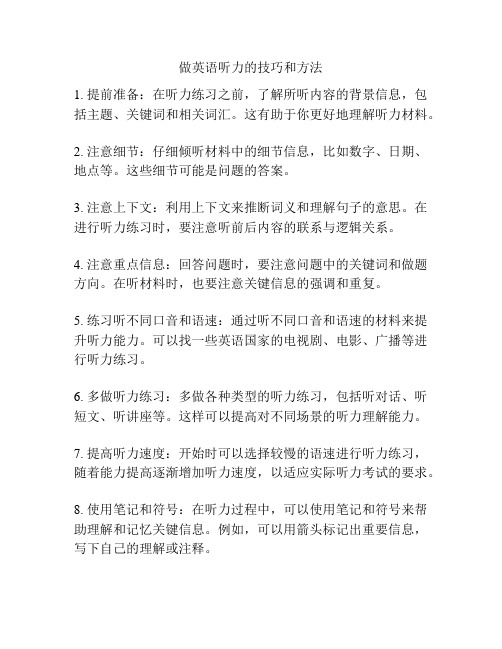
做英语听力的技巧和方法
1. 提前准备:在听力练习之前,了解所听内容的背景信息,包括主题、关键词和相关词汇。
这有助于你更好地理解听力材料。
2. 注意细节:仔细倾听材料中的细节信息,比如数字、日期、地点等。
这些细节可能是问题的答案。
3. 注意上下文:利用上下文来推断词义和理解句子的意思。
在进行听力练习时,要注意听前后内容的联系与逻辑关系。
4. 注意重点信息:回答问题时,要注意问题中的关键词和做题方向。
在听材料时,也要注意关键信息的强调和重复。
5. 练习听不同口音和语速:通过听不同口音和语速的材料来提升听力能力。
可以找一些英语国家的电视剧、电影、广播等进行听力练习。
6. 多做听力练习:多做各种类型的听力练习,包括听对话、听短文、听讲座等。
这样可以提高对不同场景的听力理解能力。
7. 提高听力速度:开始时可以选择较慢的语速进行听力练习,随着能力提高逐渐增加听力速度,以适应实际听力考试的要求。
8. 使用笔记和符号:在听力过程中,可以使用笔记和符号来帮助理解和记忆关键信息。
例如,可以用箭头标记出重要信息,写下自己的理解或注释。
9. 反思分析:练习完成后,回顾听力材料,分析自己在听的过程中出现的问题,并思考改进的方法。
定期进行反思和总结,有助于提高听力技巧。
10. 练习多样化:除了完成一些标准的听力练习,还可以尝试其他形式的听力训练,如听语音材料、听音乐歌词、听英文电台等。
这样可以增加听力的兴趣和乐趣,加强对不同语言形式的理解。
如何提高英语听力技巧五个高效方法
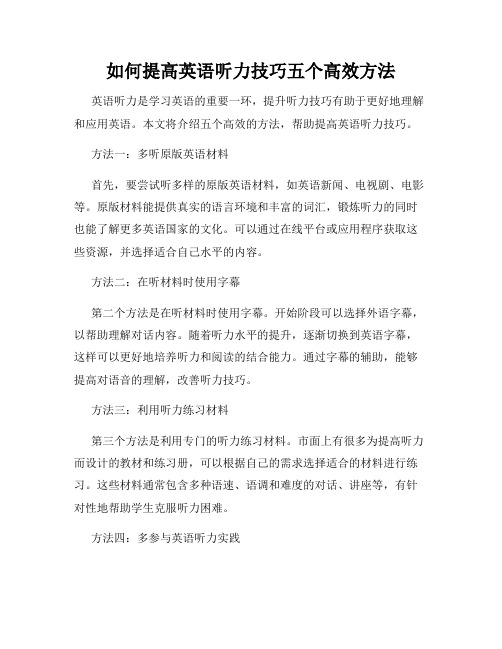
如何提高英语听力技巧五个高效方法英语听力是学习英语的重要一环,提升听力技巧有助于更好地理解和应用英语。
本文将介绍五个高效的方法,帮助提高英语听力技巧。
方法一:多听原版英语材料首先,要尝试听多样的原版英语材料,如英语新闻、电视剧、电影等。
原版材料能提供真实的语言环境和丰富的词汇,锻炼听力的同时也能了解更多英语国家的文化。
可以通过在线平台或应用程序获取这些资源,并选择适合自己水平的内容。
方法二:在听材料时使用字幕第二个方法是在听材料时使用字幕。
开始阶段可以选择外语字幕,以帮助理解对话内容。
随着听力水平的提升,逐渐切换到英语字幕,这样可以更好地培养听力和阅读的结合能力。
通过字幕的辅助,能够提高对语音的理解,改善听力技巧。
方法三:利用听力练习材料第三个方法是利用专门的听力练习材料。
市面上有很多为提高听力而设计的教材和练习册,可以根据自己的需求选择适合的材料进行练习。
这些材料通常包含多种语速、语调和难度的对话、讲座等,有针对性地帮助学生克服听力困难。
方法四:多参与英语听力实践第四个方法是积极参与英语听力实践。
可以通过与母语为英语的老师或者语言伙伴进行交流,参加英语角或英语讨论组等活动,提高听力技巧。
与母语者的沟通能够提升对快速口语和不同口音的理解能力,拓宽自己的听力范围。
方法五:注意提高听力的生活习惯最后一个方法是调整生活习惯以提高听力水平。
可以通过多听英语音乐或者播客,学习英语歌曲或演讲等,增加对英语语音和节奏的感知。
此外,可以尝试进行无字幕的听力锻炼,如闭眼聆听英语材料等,激发听觉反应,培养纯粹的听力能力。
在实践这五个高效方法的同时,需要不断注重细节和坚持。
提高英语听力技巧需要时间和耐心,但只要坚持下去,进步将会不可避免。
希望以上方法对提高英语听力技巧有所帮助。
高考英语听力提升方法(五篇)

高考英语听力提升方法(五篇)高考英语听力提升方法 11、听力速度训练听力速度直接关系到听力测试的成败,而且是影响考生测试心理的一个重要因素。
测试中因为一道题没跟上而顿时慌乱,接连丢失几题的情况并不罕见。
科学训练听力速度就要循序渐进,即由慢速到快速,逐步提高。
这种方法可使初学者逐渐适应有声信息的接受方式,树立起听的信心。
一般听力测试的.语速是英语本族人讲英语的正常速度。
为使大脑尽早适应这种语速,宜从一开始就以这种速度进行训练。
初级阶段会出现听完之后大脑中对所听内容没有什么印象的现象,但不必担忧,因为在这种语速的不断“轰击”下,耳朵会逐渐敏锐,从开始只能抓住只言片语到能接受一个完整句子,直至大脑完全适应了这种语速,接下来便是行使其记忆与判断的功能了。
在听力速度训练中要抓住速度这个主要矛盾,采用语法及词汇比较浅显而语速正常的有声材料。
2、提高词汇量英语的词汇量太少,一般一句话里面只要有一个或多个关键字听不懂,那么这句话就全听不懂了,就算部分明白了,意思也会理解相差太远,所以要加大词汇量,也许我们会看到英语的词汇量浩瀚无穷,生怕学不会不上,但不用紧张,我们只要多了解日常生活用于的词汇量就可以了,常用的词汇量不会很多的,先加强学*常用词汇,慢慢地扩大词汇范围,英语就慢慢地上去了。
3、听力理解训练要提高听力,首先应从多听教学听力录音带入手,如所学的课本录音带、口语教材录音带,也可以选听结合或略高于自己水*的有趣材料。
对所选的听力材料要区分为精听和泛听两种。
无论是精听还是泛听,开始都不要看文字材料。
精听应先把录音内容从头至尾听一遍,再把听不懂的地方一遍又一遍地反复听。
若有些地方实在听不懂,也应尽量听清各个音节,然后翻开书看看,有些影响理解的生词可查一下词典。
接着再合上书从头至尾听,直到能够听懂全部内容为止。
通过这样的听力训练,可促使自己提高辨音及理解能力。
高考英语听力提升方法 2试听文题,调整心理听力测试要求同学们有较好的心理素质。
提高英语听力的十大方法
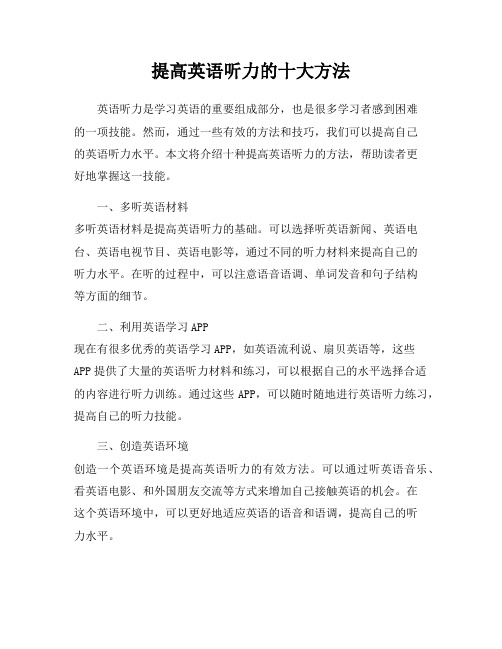
提高英语听力的十大方法英语听力是学习英语的重要组成部分,也是很多学习者感到困难的一项技能。
然而,通过一些有效的方法和技巧,我们可以提高自己的英语听力水平。
本文将介绍十种提高英语听力的方法,帮助读者更好地掌握这一技能。
一、多听英语材料多听英语材料是提高英语听力的基础。
可以选择听英语新闻、英语电台、英语电视节目、英语电影等,通过不同的听力材料来提高自己的听力水平。
在听的过程中,可以注意语音语调、单词发音和句子结构等方面的细节。
二、利用英语学习APP现在有很多优秀的英语学习APP,如英语流利说、扇贝英语等,这些APP提供了大量的英语听力材料和练习,可以根据自己的水平选择合适的内容进行听力训练。
通过这些APP,可以随时随地进行英语听力练习,提高自己的听力技能。
三、创造英语环境创造一个英语环境是提高英语听力的有效方法。
可以通过听英语音乐、看英语电影、和外国朋友交流等方式来增加自己接触英语的机会。
在这个英语环境中,可以更好地适应英语的语音和语调,提高自己的听力水平。
四、使用字幕在看英语电影或者英语视频时,可以使用字幕来帮助理解。
开始时可以选择中文字幕,逐渐过渡到英文字幕,最后尝试不使用字幕。
通过使用字幕,可以提高自己对英语听力的理解能力,逐渐适应不使用字幕的情况。
五、多做听力练习多做听力练习是提高英语听力的关键。
可以选择一些专门的听力练习材料,如《剑桥雅思听力真题》、《托福听力官方指南》等,通过不断的练习来提高自己的听力技能。
在做听力练习时,可以注意听力材料中的关键词、上下文信息等,提高自己的听力理解能力。
六、注意听力技巧在进行英语听力时,可以注意一些听力技巧。
比如,可以通过预测答案、留意关键词、注意上下文等方式来提高自己的听力理解能力。
同时,可以通过反复听某一段对话或者文章来加深对其中内容的理解。
七、跟读英语材料跟读英语材料是提高英语听力的有效方法之一。
可以选择一些英语口语材料,如英语口语教材、英语电影对话等,通过模仿和跟读来提高自己的听力技能。
英语听力训练的技巧和建议

英语听力训练的技巧和建议英语听力是学习英语的重要组成部分,对于提高英语水平起着至关重要的作用。
然而,很多学习者在听力方面遇到了困难。
本文将为大家提供一些英语听力训练的技巧和建议,帮助大家突破听力难关。
第一,多听英语材料。
要提高听力能力,必须多听英语,尽可能多地接触英语环境。
可以通过听英语歌曲、看英语电影和电视剧、听英语广播和新闻等方式来增加接触英语的机会。
此外,还可以选择一些专门的英语听力材料,如英语听力教材、网上英语听力资源等。
多听英语能够让我们熟悉英语的发音、语调和常用表达方式,从而提高听力理解能力。
第二,注意听力环境。
在进行英语听力训练时,选择一个相对安静、没有干扰的环境会更有利于我们的听力学习。
可以选择在图书馆、自习室或者私人空间进行听力练习,避免嘈杂的环境对我们的学习造成干扰。
第三,练习听力题型。
在进行英语听力训练时,我们需要熟悉各种常见的听力题型,如听对话回答问题、听长对话回答问题、听短文回答问题等等。
我们可以通过做一些针对性的听力练习来提高自己对不同题型的应对能力。
可以选择一些专门的听力练习册或者网上的听力练习资源进行练习。
第四,提高词汇量。
词汇是听力理解的基础,只有掌握了足够的词汇量,才能更好地理解听力材料。
因此,我们需要不断地扩充自己的词汇量,通过背单词、阅读和听力练习等方式来提高自己的词汇水平。
第五,学会捕捉关键词。
在进行听力训练时,我们可以通过捕捉关键词来快速理解听力材料的意思。
可以通过重点标记或者记笔记的方式来帮助我们记住关键信息。
逐渐习惯这种方法后,我们在面对听力材料时能够更快地获取有效信息。
第六,多进行听力复述。
听力复述是一个非常有效的听力训练方式。
我们可以找一些短文或者听力材料进行听力练习,然后试着将听到的内容用自己的语言进行复述。
这样可以提高我们的听力理解能力,同时也可以加强我们的口语表达能力。
综上所述,通过多听英语材料、注意听力环境、练习听力题型、提高词汇量、学会捕捉关键词和进行听力复述等方法,我们可以有效地提高自己的英语听力水平。
英语听力技巧(优秀10篇)
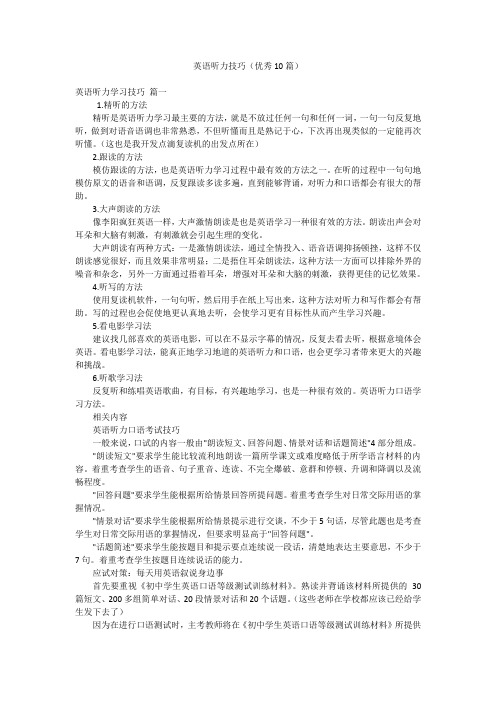
英语听力技巧(优秀10篇)英语听力学习技巧篇一1.精听的方法精听是英语听力学习最主要的方法,就是不放过任何一句和任何一词,一句一句反复地听,做到对语音语调也非常熟悉,不但听懂而且是熟记于心,下次再出现类似的一定能再次听懂。
(这也是我开发点滴复读机的出发点所在)2.跟读的方法模仿跟读的方法,也是英语听力学习过程中最有效的方法之一。
在听的过程中一句句地模仿原文的语音和语调,反复跟读多读多遍,直到能够背诵,对听力和口语都会有很大的帮助。
3.大声朗读的方法像李阳疯狂英语一样,大声激情朗读是也是英语学习一种很有效的方法。
朗读出声会对耳朵和大脑有刺激,有刺激就会引起生理的变化。
大声朗读有两种方式:一是激情朗读法,通过全情投入、语音语调抑扬顿挫,这样不仅朗读感觉很好,而且效果非常明显;二是捂住耳朵朗读法,这种方法一方面可以排除外界的噪音和杂念,另外一方面通过捂着耳朵,增强对耳朵和大脑的刺激,获得更佳的记忆效果。
4.听写的方法使用复读机软件,一句句听,然后用手在纸上写出来,这种方法对听力和写作都会有帮助。
写的过程也会促使地更认真地去听,会使学习更有目标性从而产生学习兴趣。
5.看电影学习法建议找几部喜欢的英语电影,可以在不显示字幕的情况,反复去看去听,根据意境体会英语。
看电影学习法,能真正地学习地道的英语听力和口语,也会更学习者带来更大的兴趣和挑战。
6.听歌学习法反复听和练唱英语歌曲,有目标,有兴趣地学习,也是一种很有效的。
英语听力口语学习方法。
相关内容英语听力口语考试技巧一般来说,口试的内容一般由"朗读短文、回答问题、情景对话和话题简述"4部分组成。
"朗读短文"要求学生能比较流利地朗读一篇所学课文或难度略低于所学语言材料的内容。
着重考查学生的语音、句子重音、连读、不完全爆破、意群和停顿、升调和降调以及流畅程度。
"回答问题"要求学生能根据所给情景回答所提问题。
高考英语听力的提高技巧及训练方法
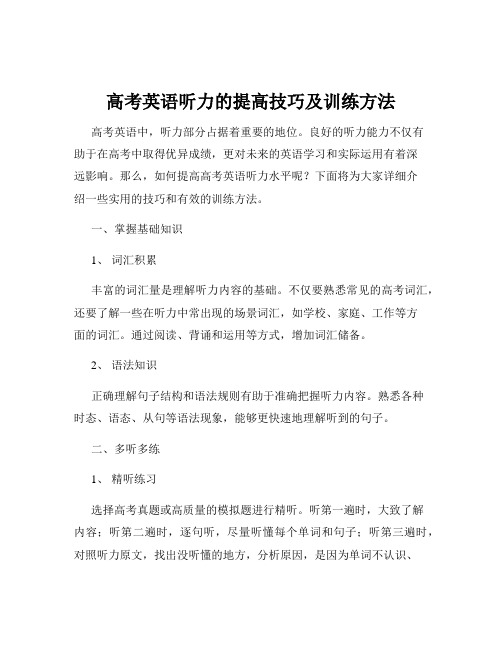
高考英语听力的提高技巧及训练方法高考英语中,听力部分占据着重要的地位。
良好的听力能力不仅有助于在高考中取得优异成绩,更对未来的英语学习和实际运用有着深远影响。
那么,如何提高高考英语听力水平呢?下面将为大家详细介绍一些实用的技巧和有效的训练方法。
一、掌握基础知识1、词汇积累丰富的词汇量是理解听力内容的基础。
不仅要熟悉常见的高考词汇,还要了解一些在听力中常出现的场景词汇,如学校、家庭、工作等方面的词汇。
通过阅读、背诵和运用等方式,增加词汇储备。
2、语法知识正确理解句子结构和语法规则有助于准确把握听力内容。
熟悉各种时态、语态、从句等语法现象,能够更快速地理解听到的句子。
二、多听多练1、精听练习选择高考真题或高质量的模拟题进行精听。
听第一遍时,大致了解内容;听第二遍时,逐句听,尽量听懂每个单词和句子;听第三遍时,对照听力原文,找出没听懂的地方,分析原因,是因为单词不认识、发音不准确还是语法不熟悉。
然后反复听这些没听懂的部分,直到完全听懂。
2、泛听练习利用课余时间进行泛听,如听英语广播、看英语电影、听英语歌曲等。
泛听的目的是培养英语语感,熟悉英语的语音、语调、语速。
三、培养听力技巧1、预测内容在听力开始前,迅速浏览题目和选项,根据所给信息预测听力内容的主题和可能涉及的问题。
这样在听的过程中就能更有针对性地捕捉关键信息。
2、抓关键词在听力过程中,要善于抓住关键词,如人名、地名、时间、数字、转折词等。
这些关键词往往是理解听力内容的关键。
3、注意语气和语调说话者的语气和语调可以传达很多信息,如肯定、否定、疑问、惊讶等。
通过注意语气和语调,可以更好地理解说话者的意图。
四、提高自身发音1、模仿标准发音通过模仿英语原声,如听力材料中的录音、英语电影中的对白等,纠正自己的发音错误,提高发音的准确性。
2、朗读练习每天坚持朗读英语文章,不仅可以提高口语表达能力,还能增强对英语语音、语调的敏感度,从而有助于提高听力水平。
五、创造英语环境1、用英语交流在日常生活中,尽量创造用英语交流的机会,如与同学用英语讨论问题、参加英语角等。
提高英语听力的方法技巧总结大全

提高英语听力的方法技巧总结大全英语听力是学习英语过程中非常重要的一项技能,也是很多学习者感到困难的一部分。
下面是一些有效的方法和技巧,可以帮助你提高英语听力水平。
1.聆听大量的英语材料为了提高听力技能,最重要的是多听英语。
可以从简单的材料开始,逐渐增加难度。
可以听新闻、录音、有声读物、英语电视节目和电影等。
2.使用有文字的材料在初学阶段,可以使用有文字的材料配合听力练习。
可以选择有文字的歌曲、英语广播或者学习材料,同时边听边阅读,这样可以帮助你更好地理解听到的内容。
3.注重细节在聆听过程中,要注重细节。
试着捕捉关键词、重要信息和语法结构,这有助于你更好地理解整个句子和段落的意思。
4.学习常用词和短语掌握常用的英语词汇和短语是提高听力的基础。
通过学习常见的词汇和短语,你可以更好地理解句子的含义。
5.练习听力材料的多样性听不同的材料,比如新闻、讲座、音乐等,可以帮助你习惯不同的语速、口音和语气。
这样你就能更好地适应不同的听力情境。
6.跟读和模仿通过跟读和模仿母语者的发音、语调和语速,可以提高你的听力水平。
可以选择录音或者视频,边听边模仿。
7.利用互动学习资源利用各种互动学习资源,比如英语播客、在线听力课程、语音对话课程等,可以增加你的听力机会和练习的时间。
8.制定听力计划根据个人的学习目标和时间安排,制定一个听力计划。
可以每天定期听一段英语材料,逐渐增加听力的难度和时间。
9.提高听力速度提高你的听力速度是提高听力技能的重要一环。
可以通过听力练习和速度训练来提高你的听力速度。
10.分析并解决困难在听力练习过程中,你可能会遇到一些困难,比如听不懂一些单词或者句子。
当遇到困难时,要及时分析问题所在,并采取措施解决问题,比如查字典、多次重听等。
11.多练习听力填空和选择题通过练习听力填空和选择题,可以提高你捕捉关键信息、听懂细节的能力。
可以选择一些听力练习书籍或者在线资源进行练习。
12.听自然语速的英语材料尽量听自然语速的英语材料,这样能更好地适应真实情境中的听力。
如何有效训练英语听力-提升方法-练习技巧
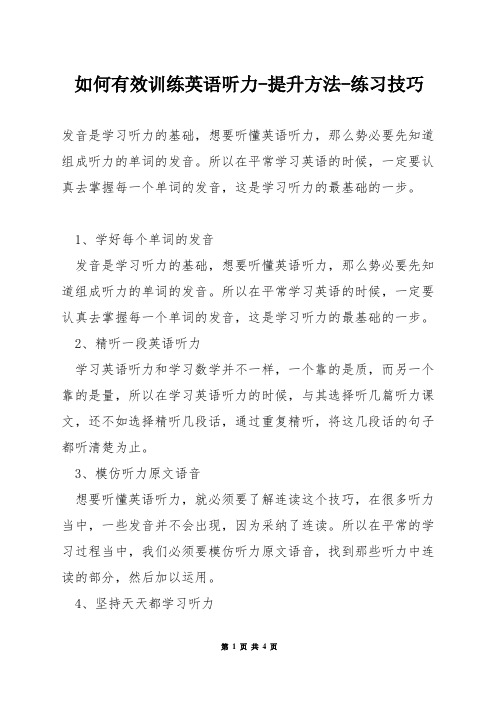
如何有效训练英语听力-提升方法-练习技巧发音是学习听力的基础,想要听懂英语听力,那么势必要先知道组成听力的单词的发音。
所以在平常学习英语的时候,一定要认真去掌握每一个单词的发音,这是学习听力的最基础的一步。
1、学好每个单词的发音发音是学习听力的基础,想要听懂英语听力,那么势必要先知道组成听力的单词的发音。
所以在平常学习英语的时候,一定要认真去掌握每一个单词的发音,这是学习听力的最基础的一步。
2、精听一段英语听力学习英语听力和学习数学并不一样,一个靠的是质,而另一个靠的是量,所以在学习英语听力的时候,与其选择听几篇听力课文,还不如选择精听几段话,通过重复精听,将这几段话的句子都听清楚为止。
3、模仿听力原文语音想要听懂英语听力,就必须要了解连读这个技巧,在很多听力当中,一些发音并不会出现,因为采纳了连读。
所以在平常的学习过程当中,我们必须要模仿听力原文语音,找到那些听力中连读的部分,然后加以运用。
4、坚持天天都学习听力对英语听力的熟悉感,并不是由每次听的时间长短来决定,而是由听英语听力的次数和频率来决定。
所以在学习听力的时候,要坚持天天都进行学习,但学习的时间不宜过长。
2英语听力提升方法一,听第一遍掌握新闻的大意和主旨。
二,开始听写,开始听写时可能并不太顺利,很多语句和单词都听不懂。
这时候不用纠结听几遍,以句子为单位,每句话听懂为止。
必须要提醒的是,听写时用手写而不是使用〔电脑〕Word 文档。
因为Word文档有自动矫正单词错误的功能,这样不利于错误单词的修改。
三,听写检查,听完一篇新闻之后,播放录音与听写的文本对照答案,看那些语句没有听写正确或是遗漏,再次修改答案。
最后才与正确的文本对照四,诵读新闻,答案对照完成之后要背诵新闻。
每听写完一篇新闻必定会积存不少的生词和新的语法知识。
背诵这篇新闻的目的很简单就是记忆这些单词和语句。
以上就是听力的学习方法,具体的学习时间可以依据自身状况安排。
不过大多数人的学习时间都安排在早上,因为早上的时间充裕,精力充沛。
听力训练的技巧与方法
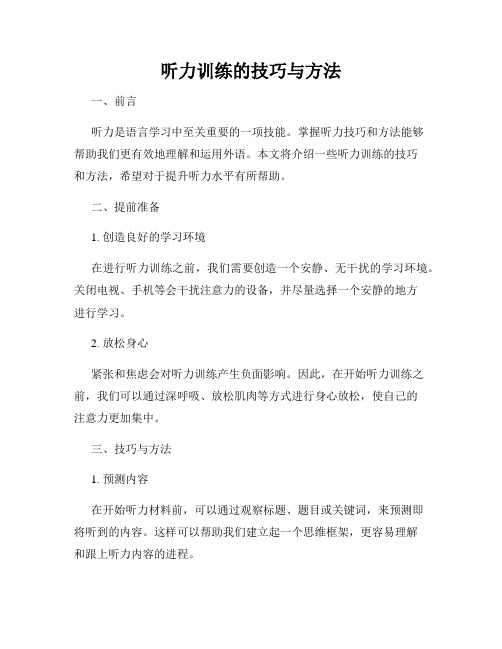
听力训练的技巧与方法一、前言听力是语言学习中至关重要的一项技能。
掌握听力技巧和方法能够帮助我们更有效地理解和运用外语。
本文将介绍一些听力训练的技巧和方法,希望对于提升听力水平有所帮助。
二、提前准备1. 创造良好的学习环境在进行听力训练之前,我们需要创造一个安静、无干扰的学习环境。
关闭电视、手机等会干扰注意力的设备,并尽量选择一个安静的地方进行学习。
2. 放松身心紧张和焦虑会对听力训练产生负面影响。
因此,在开始听力训练之前,我们可以通过深呼吸、放松肌肉等方式进行身心放松,使自己的注意力更加集中。
三、技巧与方法1. 预测内容在开始听力材料前,可以通过观察标题、题目或关键词,来预测即将听到的内容。
这样可以帮助我们建立起一个思维框架,更容易理解和跟上听力内容的进程。
2. 关注关键信息在听力过程中,我们应该注意抓住关键信息。
这些信息可能是数字、特殊词汇或者是对话的关键转折点。
通过紧密关注这些信息,可以帮助我们更准确地理解听力内容。
3. 利用上下文推测如果在听力过程中遇到一些不认识的词汇或句子,我们可以通过利用上下文来推测其含义。
通过理解前后句的逻辑关系和语境,可以帮助我们更好地理解整个句子的意思。
4. 多听多练听力训练是一个长期的过程,需要不断的练习和积累。
可以选择各种听力材料,包括新闻、电影、对话等,以扩展自己的听力范围。
同时,多做一些听力练习题,加深对于不同类型听力题目的理解和应对能力。
5. 备忘关键信息在听力过程中,我们可以用简短的笔记方式记录一些关键信息。
例如,人名、数字、重要词汇等。
这样可以帮助我们更好地记住关键信息,避免在听力结束后记忆模糊。
6. 听力材料的反复利用对于比较难的听力材料,我们可以进行反复听,直到完全理解。
可以选择一些有文本对照的材料,反复听练,并逐步熟悉发音、节奏和语境。
四、总结通过运用上述的听力训练技巧和方法,我们可以提高自己的听力水平和听力理解能力。
记住,听力是一个需要长期积累和不断训练的技能,坚持练习,相信你的听力水平会不断提升。
英语听力学习的技巧和方法
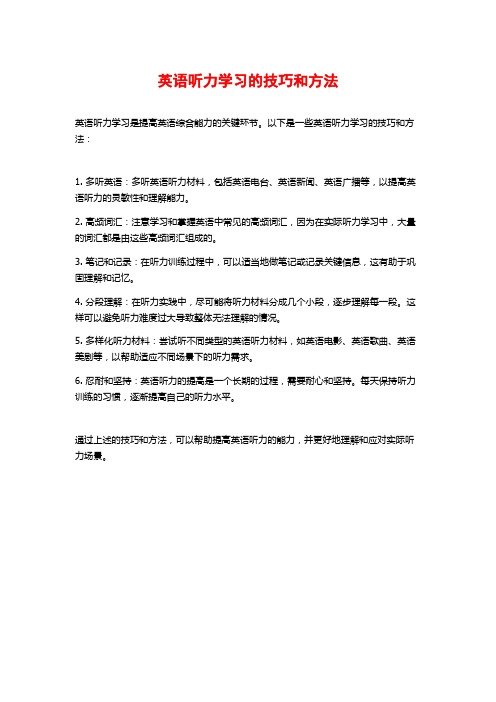
英语听力学习的技巧和方法
英语听力学习是提高英语综合能力的关键环节。
以下是一些英语听力学习的技巧和方法:
1. 多听英语:多听英语听力材料,包括英语电台、英语新闻、英语广播等,以提高英语听力的灵敏性和理解能力。
2. 高频词汇:注意学习和掌握英语中常见的高频词汇,因为在实际听力学习中,大量的词汇都是由这些高频词汇组成的。
3. 笔记和记录:在听力训练过程中,可以适当地做笔记或记录关键信息,这有助于巩固理解和记忆。
4. 分段理解:在听力实践中,尽可能将听力材料分成几个小段,逐步理解每一段。
这样可以避免听力难度过大导致整体无法理解的情况。
5. 多样化听力材料:尝试听不同类型的英语听力材料,如英语电影、英语歌曲、英语美剧等,以帮助适应不同场景下的听力需求。
6. 忍耐和坚持:英语听力的提高是一个长期的过程,需要耐心和坚持。
每天保持听力训练的习惯,逐渐提高自己的听力水平。
通过上述的技巧和方法,可以帮助提高英语听力的能力,并更好地理解和应对实际听力场景。
提高英语的听力的方法(最新9篇)
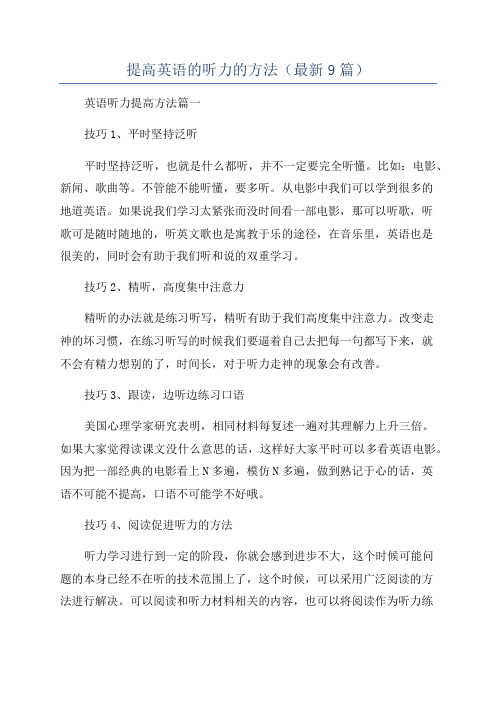
提高英语的听力的方法(最新9篇)英语听力提高方法篇一技巧1、平时坚持泛听平时坚持泛听,也就是什么都听,并不一定要完全听懂。
比如:电影、新闻、歌曲等。
不管能不能听懂,要多听。
从电影中我们可以学到很多的地道英语。
如果说我们学习太紧张而没时间看一部电影,那可以听歌,听歌可是随时随地的,听英文歌也是寓教于乐的途径,在音乐里,英语也是很美的,同时会有助于我们听和说的双重学习。
技巧2、精听,高度集中注意力精听的办法就是练习听写,精听有助于我们高度集中注意力。
改变走神的坏习惯,在练习听写的时候我们要逼着自己去把每一句都写下来,就不会有精力想别的了,时间长,对于听力走神的现象会有改善。
技巧3、跟读,边听边练习口语美国心理学家研究表明,相同材料每复述一遍对其理解力上升三倍。
如果大家觉得读课文没什么意思的话,这样好大家平时可以多看英语电影。
因为把一部经典的电影看上N多遍,模仿N多遍,做到熟记于心的话,英语不可能不提高,口语不可能学不好哦。
技巧4、阅读促进听力的方法听力学习进行到一定的阶段,你就会感到进步不大,这个时候可能问题的本身已经不在听的技术范围上了,这个时候,可以采用广泛阅读的方法进行解决。
可以阅读和听力材料相关的内容,也可以将阅读作为听力练习的辅助方法,大量地阅读小说、杂志、网络文章、新闻报道等自己感兴趣的内容。
阅读是积累词汇的最有效的方法之一提高中考英语听力方法第一步:试听文题,调整心理第二步:积极读题预测,细节莫失选项是听力理解的关键,它可以帮助我们预测将要听到的材料的内容,也可提示所听的重点。
因此听音前五分钟,要看清大小题目要求、问题与选项,不要放过任何一个细节。
在浏览问题和选项时,要尽可能对文章内容和试题答案进行预测,听录音时只要验证自己的预测就可以了例如:1、 This article(文章) is talking about _________ names.A. EnglishB. AmericanC. ChineseD. School2、In “John Henry Brown”,John is the _________ name.A. familyB. firstC. secondD. full3、 English people often put Mr, Mrs and Miss before the_________ name.A. familyB. secondC. firstD. full4、 Many English people have _________ names.A. twoB. threeC. fourD. only one通过阅读题目及选项,我们可以获得这样的信息:这篇听力材料讲的是关于英、美国家人的姓名的短文。
英语听力的方法技巧大全
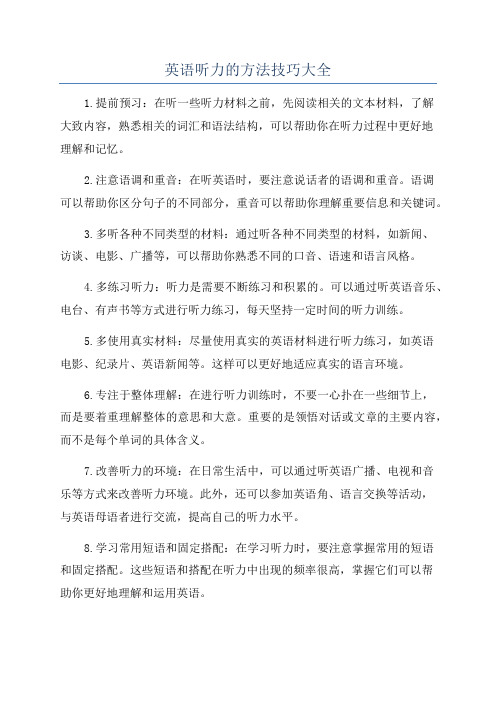
英语听力的方法技巧大全1.提前预习:在听一些听力材料之前,先阅读相关的文本材料,了解大致内容,熟悉相关的词汇和语法结构,可以帮助你在听力过程中更好地理解和记忆。
2.注意语调和重音:在听英语时,要注意说话者的语调和重音。
语调可以帮助你区分句子的不同部分,重音可以帮助你理解重要信息和关键词。
3.多听各种不同类型的材料:通过听各种不同类型的材料,如新闻、访谈、电影、广播等,可以帮助你熟悉不同的口音、语速和语言风格。
4.多练习听力:听力是需要不断练习和积累的。
可以通过听英语音乐、电台、有声书等方式进行听力练习,每天坚持一定时间的听力训练。
5.多使用真实材料:尽量使用真实的英语材料进行听力练习,如英语电影、纪录片、英语新闻等。
这样可以更好地适应真实的语言环境。
6.专注于整体理解:在进行听力训练时,不要一心扑在一些细节上,而是要着重理解整体的意思和大意。
重要的是领悟对话或文章的主要内容,而不是每个单词的具体含义。
7.改善听力的环境:在日常生活中,可以通过听英语广播、电视和音乐等方式来改善听力环境。
此外,还可以参加英语角、语言交换等活动,与英语母语者进行交流,提高自己的听力水平。
8.学习常用短语和固定搭配:在学习听力时,要注意掌握常用的短语和固定搭配。
这些短语和搭配在听力中出现的频率很高,掌握它们可以帮助你更好地理解和运用英语。
9.训练听力速度:逐渐提高听力速度是提高听力能力的关键。
可以通过听速度较快的材料进行练习,逐渐适应快速听力的要求。
10.加强词汇积累:良好的词汇积累是听力能力的基础。
可以通过背单词、阅读英语材料等方式来扩大词汇量,加强听力的理解能力。
11.利用上下文信息:在进行听力时,要善于利用上下文信息来理解单词和句子的意思。
通常上下文提供的信息可以帮助你推测出单词的含义和句子的意思。
12.练习听力笔记:在听一段话或文章后,尝试用英文写下关键信息,包括主要观点、细节、例子等。
这样可以帮助你加强对听力材料的记忆和理解。
做英语听力题的方法和技巧

做英语听力题的方法和技巧英语听力是语言学习中的一项重要技能,也是各类英语水平测试中的必考环节。
提高英语听力不仅能帮助我们更好地理解和运用英语,还能拓宽我们的视野,增进对外部世界的了解。
本文将详细探讨做英语听力题的方法和技巧,帮助读者提升英语听力水平。
一、听力前的准备工作1. 调整心态:听力测试前,保持冷静和自信是很重要的。
紧张的情绪会影响我们的注意力和理解能力。
因此,在开始听力测试前,做一些深呼吸,放松身心,有助于提升听力效果。
2. 预测内容:在听力材料播放前,通常会有一段时间供我们阅读问题和选项。
这段时间应被充分利用来预测听力材料的大致内容。
通过浏览问题和选项,我们可以对即将听到的信息有一个初步的了解,从而在听的过程中更加有针对性地捕捉关键信息。
3. 词汇和语法准备:扩大词汇量,熟悉常用语法结构对提高听力理解能力至关重要。
建议平时多读多听,积累常用词汇和短语,并熟悉它们在句子中的用法。
二、听力过程中的技巧1. 抓住关键词:在听的过程中,不必过分纠结于每个单词的发音和意思,而是要抓住关键词和关键信息。
这些信息通常会帮助我们理解听力材料的主旨和要点。
2. 记笔记:听力过程中,快速而简洁地记笔记是一个好习惯。
这有助于我们在听后回顾和验证所听到的信息,特别是在听力材料较长或信息较复杂的情况下。
3. 推断和猜测:当遇到不熟悉的词汇或短语时,不要惊慌。
根据上下文和语境进行推断和猜测是一个有效的策略。
同时,利用已知的信息来推测未知的信息也是一个重要的技巧。
4. 注意听力材料的结构和逻辑:听力材料通常会有一定的结构和逻辑顺序。
注意听开头和结尾,它们往往会包含重要的总结性信息。
同时,也要注意听力材料中的转折词和连接词,它们会提示我们信息的转换和逻辑关系。
三、听力后的总结和反思1. 核对答案:听力测试结束后,及时核对答案是很有必要的。
这不仅可以让我们了解自己的得分情况,还可以帮助我们找出听力理解中的薄弱环节。
2. 分析错误原因:对于答错的题目,要仔细分析错误原因。
提高听力成绩的七个技巧与方法
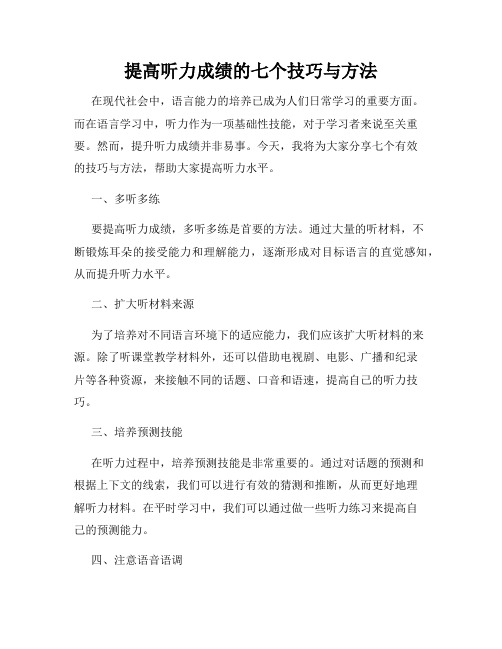
提高听力成绩的七个技巧与方法在现代社会中,语言能力的培养已成为人们日常学习的重要方面。
而在语言学习中,听力作为一项基础性技能,对于学习者来说至关重要。
然而,提升听力成绩并非易事。
今天,我将为大家分享七个有效的技巧与方法,帮助大家提高听力水平。
一、多听多练要提高听力成绩,多听多练是首要的方法。
通过大量的听材料,不断锻炼耳朵的接受能力和理解能力,逐渐形成对目标语言的直觉感知,从而提升听力水平。
二、扩大听材料来源为了培养对不同语言环境下的适应能力,我们应该扩大听材料的来源。
除了听课堂教学材料外,还可以借助电视剧、电影、广播和纪录片等各种资源,来接触不同的话题、口音和语速,提高自己的听力技巧。
三、培养预测技能在听力过程中,培养预测技能是非常重要的。
通过对话题的预测和根据上下文的线索,我们可以进行有效的猜测和推断,从而更好地理解听力材料。
在平时学习中,我们可以通过做一些听力练习来提高自己的预测能力。
四、注意语音语调在提高听力成绩的过程中,注意语音语调也是非常关键的。
正确的语音语调可以帮助我们更好地理解听力材料。
我们可以通过模仿母语者的发音,注意重读和连读的特点,逐渐熟悉目标语言的语音规律,提高听力技巧。
五、提高词汇量词汇的积累对于提高听力成绩非常重要。
在做听力练习时,经常会遇到一些生词和短语。
如果我们的词汇量不够,就会影响对听力材料的理解。
因此,我们要注重词汇的积累,不断扩大自己的词汇量,这样才能更好地理解听力内容。
六、注意听力策略在进行听力考试时,我们应该注意一些听力策略,以提高解题的准确性和效率。
比如,在做选择题时,可以先阅读选项,然后有针对性地关注相关信息;在填空题中,可以根据上下文来预测正确的单词等。
掌握这些听力策略可以帮助我们更好地应对听力考试。
七、反复听、分析和总结最后一个方法是反复听、分析和总结。
在完成一篇听力材料后,我们可以多次回放,逐渐理解其中的细节和意义。
同时,我们也可以将听力材料中的常用句型、表达方式等内容进行总结,以便在以后的学习中加以运用。
听力训练:听取短文并回答问题的技巧培养
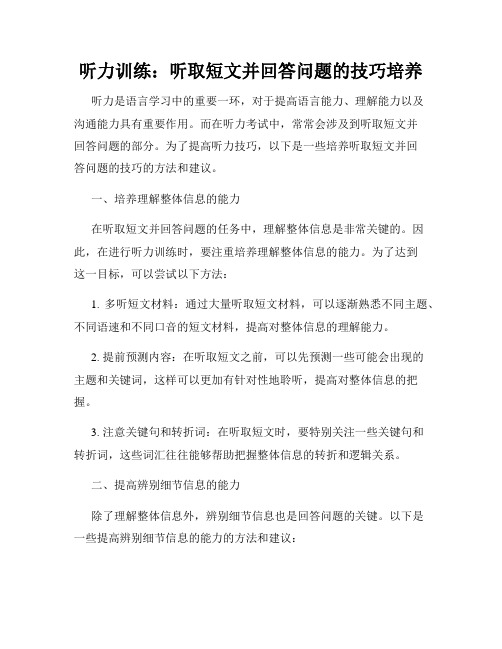
听力训练:听取短文并回答问题的技巧培养听力是语言学习中的重要一环,对于提高语言能力、理解能力以及沟通能力具有重要作用。
而在听力考试中,常常会涉及到听取短文并回答问题的部分。
为了提高听力技巧,以下是一些培养听取短文并回答问题的技巧的方法和建议。
一、培养理解整体信息的能力在听取短文并回答问题的任务中,理解整体信息是非常关键的。
因此,在进行听力训练时,要注重培养理解整体信息的能力。
为了达到这一目标,可以尝试以下方法:1. 多听短文材料:通过大量听取短文材料,可以逐渐熟悉不同主题、不同语速和不同口音的短文材料,提高对整体信息的理解能力。
2. 提前预测内容:在听取短文之前,可以先预测一些可能会出现的主题和关键词,这样可以更加有针对性地聆听,提高对整体信息的把握。
3. 注意关键句和转折词:在听取短文时,要特别关注一些关键句和转折词,这些词汇往往能够帮助把握整体信息的转折和逻辑关系。
二、提高辨别细节信息的能力除了理解整体信息外,辨别细节信息也是回答问题的关键。
以下是一些提高辨别细节信息的能力的方法和建议:1. 练习听写:通过听写的方式,可以提高对细节信息的捕捉能力。
可以选择一些适合自己水平的短篇文章进行听写,然后核对答案,找出自己在听写过程中出现的问题。
2. 学会捕捉关键词:在听取短文时,要学会捕捉关键词。
这些关键词往往与问题有关,通过捕捉关键词,可以更快地找到问题的答案。
3. 注意数字和时间:在一些听力材料中,会出现数字和时间的信息。
对于这些信息,要特别注意准确地捕捉和记忆,以便回答相关问题。
三、加强细节衔接的能力在听取短文并回答问题的任务中,有时需要将不同细节进行衔接,得出问题的答案。
以下是一些加强细节衔接能力的建议:1. 练习插入题:插入题是指在短文中插入一个新的问题,要求考生根据听到的信息得出答案。
通过练习插入题,可以提高捕捉和衔接细节的能力。
2. 注意上下文的逻辑关系:在听取短文时,要注意上下文的逻辑关系,尤其是一些表示因果关系、转折关系和时间先后关系的词语。
提高英语听力的方法技巧总结

提高英语听力的方法技巧总结英语听力是学习英语的关键部分之一,也是很多学习者感到困难的地方。
在提高英语听力水平方面,以下是一些有效的方法和技巧:1.聆听自然语速的英语材料:选择一些自然语速的英语材料,如英语电影、纪录片、英语新闻等。
这样可以让你更好地适应真实的英语听力环境。
2.练习听力理解:选择一些适合自己水平的英语听力材料进行练习,如听力录音、英语电台、英语播客等。
在听的过程中,可以做一些相关的听力理解练习,如听后回答问题、填写听到的内容等。
3.多听多练:通过高频地听听力材料,让自己熟悉英语的语音、语调和常用词汇。
如果条件允许的话,可以每天都进行一些英语听力练习。
4.切换到英语环境:尽量将自己置身于英语环境中,如看英语电影、听英语歌曲、与英语母语者交流等。
这样可以让你更好地融入到英语的语言环境中,提高听力的接受能力。
5.提前预测听力材料:在开始听一些英语材料之前,尝试预测听到的内容。
这样可以让你更加专注于听力内容,提高听力的理解能力。
6.注意语音语调:注意英语的语音语调,特别是重音和连读现象。
这些对于理解英语听力材料非常重要。
7.词汇积累与语境理解:积累常用的英语词汇,并了解这些词汇的不同含义和用法。
同时,注意理解英语听力材料中的语境,通过语境来推测不熟悉的词汇的含义。
8.多样化听力材料:尝试听不同种类的英语材料,如不同主题的英语新闻、访谈、教育视频等。
这样可以提高你在不同主题和场景下的听力能力。
9.提高听力速度:尝试逐渐提高听力的速度,从慢速到正常速度。
先通过慢速的英语材料来提高听力的理解,然后逐渐过渡到正常速度的材料。
10.多角度听:在听一些英语材料时,尝试从不同的角度出发来理解材料,如通过听词汇、短语、句子结构等。
12.学习听力策略:学习一些有效的听力策略,如关键词捕捉、理解句子的关系、预测听到的内容等。
总之,提高英语听力需要长期的练习和坚持,同时不断学习和掌握听力技巧。
通过以上的方法和技巧,相信你的英语听力水平会得到显著提高。
- 1、下载文档前请自行甄别文档内容的完整性,平台不提供额外的编辑、内容补充、找答案等附加服务。
- 2、"仅部分预览"的文档,不可在线预览部分如存在完整性等问题,可反馈申请退款(可完整预览的文档不适用该条件!)。
- 3、如文档侵犯您的权益,请联系客服反馈,我们会尽快为您处理(人工客服工作时间:9:00-18:30)。
第三节听力训练的方法与技巧一、激发学生对听力训练产生兴趣的八种方法1. 视听配音:让学生看从电影录像中选取的对话片段,先视听,再关掉声音,让学生看画面配音,要求学生先要听懂,再关注语音语速,再尝试配音。
可以让部分同学在英语晚会上展示自己的配音作品。
2. 听录音讲笑话:课前,老师将录有英语笑话的录音带交给第二天的值日生,该生回去自己听,第二天给全班讲这个笑话,全班的笑声决定该生听音讲故事是否成功。
如果听者听后无反应,让全班共同来听这段笑话的录音。
3. 听录音配动作表演:放一段对话录音,要求学生听懂之后,再放录音,学生对口型( 不出声) 配动作表演,要求动作和对话内容协调一致。
4. 听录音做表情:例如听《项链》一课的录音,每组派一名同学坐在台前,听录音的过程中,他们的表情必须随内容的不同而变化,喜怒哀乐溢于言表。
听完后全班进行讨论,看谁的表情与听力内容不相符合。
5. 听录音学课文:老师事先将自己讲课的内容录制成磁带,学生通过听录音作记录,接受老师的课文教学指导,在规定的时间里,老师进行可动手( 根据自己的录音板书) 、不动口的听力课文教学。
6. 听材料,赏音乐:老师给听力材料重新加录进背景音乐,也可边听语言材料,边听播放音乐,把音乐美与语言美有机结合,创造轻松愉快的听力训练环境。
7. 设置悬念和疑问:老师通过设置悬念或疑问来培养学生对听力训练的兴趣,既能满足学生的好奇心,通过释疑又能给予学生“柳暗花明”的成就感。
(1) 开篇设疑:放录音之前,老师围绕主题或结果设计一个能打开思路、抛砖引玉的问题,如:The Memory RobotSusan,Mr.Mott's wife ,is a st year she invented the memory robot.She invented it because her husband had a very bad memory.He could not remember his telephone number.He often forgot important meetings …Teacher's question :Susan invented the memory robot because of her husband.If youwant to know further about her husband ,please listen to the tape and know the reason why.(2) 中篇设疑:可以先让学生听故事的一部分,老师一边讲解,再设置一个问题或悬念,置学生于欲罢不能的境地。
留下的部分,让学生自己听和回答问题。
(3) 结尾设疑:老师在学生听结局前围绕结局设计一个问题,先让学生猜结局或补全故事的结局,培养学生的创新思维。
当然,听力训练要激发学生兴趣还须做到听力材料的难度适当超出学生的现有水平,材料力求反映真实的生活,在训练过程中,既帮助学生理解听力内容,又给予方法指导。
有时还应该将听力训练和现实任务结合起来,用听到的信息去解决一个实际问题或完成一项有趣的任务。
8. 听后模拟活动:让学生先听语篇材料,根据他们的理解来组织模拟演练,激发学生兴趣,使“听”的单纯技能训练成为有趣的活动,变静态的听力训练为动态。
如:Children love to play this game.They play it like this :Six students stand in a row in front of the class.They put their hands behind their backs ,so nobody can see their hands.The teacher give one of them a coin.They pass the coin from one student to another — first one way ,then another.The six students must keep their hands behind their backs.The other students in the class keep their eyes closed.They must not see the process of the“passing ” .Then the teacher says, “stop and put your hands in front of you now. ”All the six students do as the teacher says.At this moment ,the teacher tells the other students to open their eyes ,and guess who has the coin.They ask questions like “David,is it in your right hand? ”They can only three guesses.设计模拟活动:Who has the ruler?听力训练步骤:第一步:听录音。
第二步:指定游戏的组织者。
第三步:学生根据听到的内容和活动方式来组织Guess Who Has the Coin 的游戏活动。
第四步:重放录音,老师评价。
二、三步听力预测验证训练法老师在听力训练前告诉学生听力材料的标题,要求学生分析标题来预测段落内容,并在老师的帮助下运用经验来推论结果。
接着,通过听来验证学生的预测并对比检测结果。
强化学生的预测判断能力,加强听力的目的性,保证听力训练的效度。
如:听力材料:Pollution第一步老师首先板书听力材料的主题—— pollution 。
第二步师生设问和讨论预测内容并推导结论:What ’s pollution ? How many kinds ? Where is it from in your opinions ? How to stop different kinds of pollution ?第三步听录音验证假设。
三、任务型听力训练法该方法要求学生在听懂的基础上,利用输入的语言信息去完成一项任务或多项任务。
这些任务是老师围绕听力材料所提供的语言情景和语言信息预先设计的,通过任务的完成和此后的评价来检验学生的理解程度。
1. 录音填表格,如:(1) 听力材料Tom ,Mike and I are sitting on a rock near the river with my friends.Our guide is cooking supper.I can smell it.We are having a wonderful time.We are in the middle of the great forest in South Africa.We can't travel through the forest by road ,because there aren't any roads.So we have to travel by air or boat.We are enjoying our boat trip very much.At night ,we tie the boat to a big tree by the river bank near a village.Our guide buys some food from the villagers and we cook it ourselves.Sometimes we eat chicken ,eggs ,birds or monkeys.I think it is wrong ,so I don't.Most of the time we eat fish.(2) 表格设计(3)听后填写2. 听后画图初级听力训练阶段需要学生运用抽象思维能力,更需要学生运用形象思维能力。
听后画图的方法旨在培养学生的空间定位能力、想象力以及信息接受、处理、联想、加工及组合能力。
以初一Lesson 46 的教学为例:Look at the picture.There is a boat on the river.There is a house near the river.Near the house there is a big tree.In the tree there is a bird.Is there a cat in the tree?No. But there is one under the tree.Is there a dog in the picture?Yes ,there is.Where is it ?第一步:老师要求学生准备画笔和纸,并给他们交代听录音画一幅画的任务。
第二步:预听内容开始画画。
第三步:复听内容,检验“画作”。
第四步:“作品”评奖,共同评价。
3. 听后写( 通知、信、邀请函等)老师选用部分应用文体做听力材料,既培养学生信息的转换能力,又强化四会技能的相互渗透,即听是写和说的基础,说和写是听的提高。
如:Attention ,please ,everyone! I have something important to say. We are to go for an outing to the East Lake the day after tomorrow. We are going to gather at the school gate at7 :30 a.m. the day after tomorrow.Please bring your lunch and soft drinks with you.Since we will have a hill climbing contest ,you should have suitable shoes on.Do remember to come on time.That 's all.Thank you.第一步:听通知录音。
第二步:要求学生根据听力内容,写书面通知。
第三步:老师给予评价。
4. 听后回答,重述,转述听后回答可采用四种问答方式:(1) 一般疑问句问答,弄清人物的职业身份,只要求学生作正误判断,目的培养学生听力的自信心;(2) 第二类问题围绕where 、when 、what 来设计,培养学生通过听来抓主要信息的能力,弄清事情经过及发生的时间地点;(3) 第三类问题围绕how 、why 来设计,引导学生对听力材料作深层次的理解,弄清事情的前因后果及方式方法;(4) 主要围绕标题内容来设计,目的帮助学生理解言外之意,促使学生能运用自己的综合语言能力进行创造性问答。
